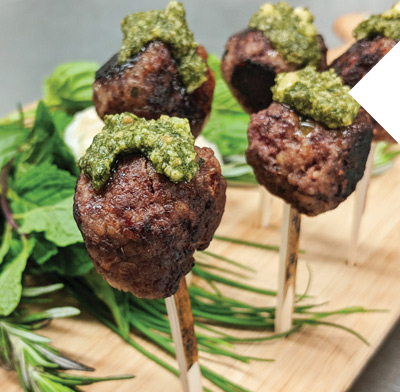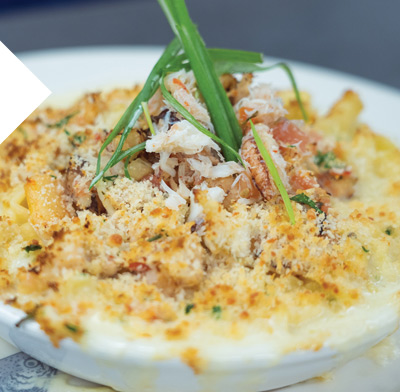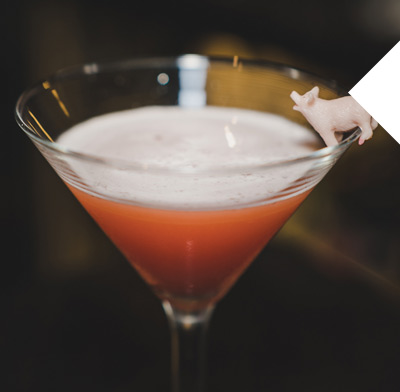As I sit in my office perched up in the attic above McMillin’s restaurant, the hammers and saws peel away layers of history as we prepare for a small remodel. The historic restaurant building was once the home of the company town overseer, John S McMillin, and later the historic restaurant that we now call McMillin’s. The restaurant opened in the spring of 1957 and was the San Juans’ first restaurant to hold a state liquor permit. With a bar in every room, the then Roche Harbor Inn featured a list of spirits prominently displayed in the center of the menu. At the time, the all-you-can-eat salad bar was a big hit, but the salt-crusted prime rib was what boaters came from near and far to enjoy. Flashforward more than 60 years, and Roche Harbor’s menu has gone through many changes as head chefs have come and gone, yet the prime rib remains on center stage of the menu.
The McMillin’s remodel will be completed in late April of this year and include a newly remodeled kitchen, fire suppression system, and some surprises in the dining room. During construction, the newly updated Madrona Grill, located on the first floor of the restaurant building, is now open with all the tempting cocktails, local beers, and mouthwatering food items with many new exciting winter additions. The Madrona Grill’s floor plan is expanded with large floor-to-ceiling sliding glass walls that open to the expansive deck and provide amazing views of the harbor and resort. During the spring and summer months, the entire restaurant will open to the deck, creating a relaxing indoor/outdoor space.
This month’s recipes include a few of our most popular Madrona Grill menu items. The Crab Pot Mac and Cheese combines a rich cream sauce (Alfredo style), Oregon’s Tillamook cheeses, and a garlicky, au gratin crispy top. Try finishing this off in a cast iron skillet in your oven, yummy! To wash all this down, get out your martini shaker and cocktail glasses for our Pig War Martini. Some of you may have a mock pig or two left over from your last cocktail at the Madrona Grill for the official garnish.
 |
Lamb Lollipops with Chimichurri SauceA couple times a year, I take a trip to Bow, Washington, and work with the team at Island Grown Farmers Cooperative. In an eight-hour day, we convert Lazy G Ranch lamb, fresh pork, vegetables, herbs, and spices into a few thousand pound of burgers, sausages, and bulk grind. The bulk grind is reserved for making lamb lollipops that are served at many weddings as a tray-passed appetizer. The flavorful lamb meatball combined with the aromatic earthy richness of the chimichurri make for a perfect accompaniment. Chimichurri was created by Basque settlers in Argentina and is open to many interpretations. While grazing their sheep, Basque shepherds would gather herbs and wild garlic as they roamed through the foothills of the Andes. When evening came, they would combine what they had collected along their journey with vinegar and olive oil from a backpack and serve the sauce with a fire-roasted chunk of fresh lamb. Makes 48 lamb meatball lollipops
Directions: In a large bowl, combine lamb burger, eggs, Parmesan cheese, and breadcrumbs. It works best to combine the mixture with your hands. After the mixture is thoroughly combined, form into 1-ounce, tightly packed little meatballs. Place lamb meatballs on a foil-lined baking sheet. Preheat oven to 350˚ F. Place baking sheet of lamb meatballs in oven and bake for about 15 minutes or until an internal temperature of 155˚ F. Allow meatballs to cool for about 5 minutes, then pierce each with a lollipop stick. In a blender or food processor add parsley, red wine vinegar, garlic, shallot, oregano, red pepper flakes, kosher salt, and olive oil. Pulse ingredients until well chopped, but not pureed. Dip each lamb lollipop in chimichurri sauce and serve warm with a side of sauce. |
Crab Pot Macaroni and CheeseMakes 4 Servings
Directions: Combine breadcrumbs, parsley, garlic, and Parmesan in a mixing bowl and slowly drizzle melted butter while stirring the breadcrumb mixture. Continue to stir the crumb mixture until the butter is evenly distributed and absorbed by the breadcrumbs. In a large non-stick saucepan over medium heat, add the garlic cream sauce, cheddar cheese, and Parmesan to the pan. When the sauce begins to bubble, add the al dente pasta and continue cooking until the pasta is warm. Place the heated pasta and cheese in a baking dish. Sprinkle the Dungeness crab meat over the top of the pasta, followed by the au gratin topping, allowing the crab to peak through. Place in a 350-degree oven and bake until the au gratin is browned and the center of the pasta is hot. Chef’s Note: We use ziti pasta because it is an unusual shape of pasta and works well in a busy sauté station in our fast-paced Madrona Grill, but any pasta shape that’s medium sized will work perfectly. Garlic Cream Sauce
Directions: Heat butter and olive oil in sauce pan until butter is melted. Add minced garlic and simmer on low heat for 5 to 8 minutes or until garlic softens. Do not allow garlic to brown, for this will make the sauce bitter. Add cream, salt, and pepper. Let sauce simmer for 20 minutes and let cream reduce by a volume of 25 percent. Stir sauce often during this process. Remove from heat, and then stir to recombine butter and cream (this step helps prevent the butter from separating). Place in a shallow container and refrigerate until needed. Chef’s Note: When preparing the Garlic Cream Sauce, it’s best to use a heavy-gauge pan to avoid the scalding cream. Au Gratin Topping
Directions: Combine breadcrumbs, Parmesan, parsley, and garlic in a small bowl. Slowly drizzle the melted butter over the breadcrumb mixture while stirring. Continue to stir the breadcrumb mixture until the butter is evenly distributed and absorbed by the breadcrumbs. Store and hold at room temperature until needed. |
 |
 |
Pig War MartiniNamed after the 1859 confrontation between the United States and United Kingdom over the British-U.S. border in the San Juan Islands, the Pig War was ignited over the death of a pig. On June 15, Lyman Cutler, an American farmer, found a large pig rooting through his potato patch. In anger, Cutler shot and killed the pig that was owned by Irishman Charles Griffin. Cutler offered $10 for the pig, but Griffin countered with $100. An argument ensued, with Cutler exclaiming, “It was eating my potatoes,” and Griffin retorting, “It’s up to you to keep your potatoes out of my pig.” When the British authorities threatened to arrest Cutler, the American called for military protection. During the 10-year standoff, not a single shot was exchanged, and the U.S. border was drawn north of San Juan Island. Griffin’s troublesome pig may have eaten his last potato, but his memory lives on with this potato vodka, orange-infused cocktail. Makes one coctkail
Directions: Fill a mixing glass with ice and pour over vodka, Cointreau, orange, cranberry juice, and pineapple juice. Using a muddler, gently press down and give a half turn of the muddler. Release and continue this motion until the orange juice essence is released and ice crystals appear. This should take about 6 to 8 turns. Strain the martini into a chilled cocktail glass and garnish with an orange twist or surprise your guest with a little rubber pink pig like one that bartenders use at the McMillin’s Fireside Lounge. Chef’s Note: A muddler is an essential bar tool and is designed to smash and mix cocktail ingredients. Muddlers and a shaker glass are to a bartender what a mortar and pestle are to a chef. Choose a muddler that is 6 to 8 inches long and 1 to 2 inches in diameter and made of wood. Like a good knife, never put your muddler in the dishwasher and wash gently by hand. |


